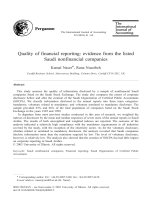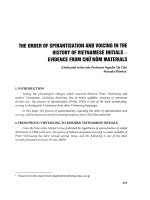Financial crisis and the resolution of financial distress evidence from malaysia and thailand
Bạn đang xem bản rút gọn của tài liệu. Xem và tải ngay bản đầy đủ của tài liệu tại đây (1.87 MB, 190 trang )
FINANCIAL CRISIS AND THE RESOLUTION OF
FINANCIAL DISTRESS: EVIDENCE FROM
MALAYSIA AND THAILAND
TAN WEI LIN
(B. Economics (Hons.), Universiti Kebangsaan Malaysia;
Master of Economics, University of Malaya)
A THESIS SUBMITTED
FOR THE DEGREE OF DOCTOR OF PHILOSOPHY
DEPARTMENT OF ECONOMICS
NATIONAL UNIVERSITY OF SINGAPORE
2008
ACKNOWLEDGEMENTS
I have benefited greatly from the guidance and support of many people
during my PhD studies in NUS.
I am heavily indebted to my supervisor, Associate Professor Aditya Goenka,
who has relentlessly provided guidance and generous support throughout my entire
candidature. I have benefited very much from his invaluable academic guidance;
insightful suggestions and his patience and kind encouragements during difficult
time. My thesis could not have been completed without his great supervision.
I am also very grateful to my thesis committee member, Dr. Kang Changhui
for his constructive advices and coaching in the technical area of my empirical
research. His patience in attending to all my queries is highly appreciated. I would
like to extend my gratitude to another thesis committee member, Professor Åke G.
Blomqvist too for his support and assistance.
I would like to thank the administrative staffs in the department as well as
the librarian for their kind assistance throughout my candidature. In addition, the
support, encouragement and friendship from my peers at NUS have made my PhD
journey more interesting.
Last but not least, the support of my family, as always, has been the
motivation behind my PhD studies. I am very grateful to my parents and siblings for
their understanding, encouragement and love throughout the years. Their
unconditional love has inspired me to give my best in my undertakings.
i
TABLE OF CONTENTS
Acknowledgements i
Table of Contents ii
Abstract vi
List of Tables viii
List of Figures x
List of Abbreviations xi
Chapter 1: Understanding the East Asian Financial Crisis: the Role of Banks in
Propagating and Amplifying Shocks
1 Introduction 1
2 Review of Literature 5
3 Malaysia and Thailand’s Experience: from Crisis to Recovery 27
4 Comparative Analysis on Policy Response in Malaysia and Thailand 34
4.1 Macroeconomic Policy 35
4.2 Policies to Deal with Banking Sector’s Distress 37
4.2.1 Overall Bank Restructuring Strategy 37
4.2.2 Asset Management Policy 41
4.2.2.1 Thailand’s Decentralised Approach 41
4.2.2.2 Malaysia’s Centralised Approach 46
4.2.2.3 Comparative Analysis on Asset Resolution Policy Response 49
5 Conclusions 49
References 51
ii
Chapter 2: Optimal Asset Resolution Policy: Centralised vs Decentralised
Approach
1 Introduction 59
2 The Basic Model 71
2.1 The Structure 71
2.2 Firm’s Behaviour 75
2.3 Bank’s Behaviour under Decentralised Approach 78
2.3.1 Bank’s Policy Choice: Bankruptcy vs Rollover 80
2.4 Nationalised Asset Management Company (NAMC) 85
2.5 Optimal Policy Choice 87
3 Financial Shocks and the Regulator’s Optimal Policy Choice 90
3.1 Extension of the Basic Model to incorporate Financial Shocks 90
3.1.1 Economy without Shock (NS) 91
3.1.2 Economy with Shock (S) 91
3.2 The Impact of Financial Shocks on the Banks’ and the NAMC’s Expected
Two- Period Net Worth 92
3.3 Financial Shocks and Optimal Policy 99
4 Discussions 100
5 Conclusions 105
Appendix 108
References 110
iii
Chapter 3: Resolving Financial Distress: Lessons from Malaysia
1 Introduction 115
2 Theoretical Underpinnings 121
2.1 The Role of NAMC in Mitigating Bargaining Frictions and
Upholding Asset Value during Systemic Financial Distress 125
2.2 Case study: Danaharta 129
2.2.1 Danaharta’s Establishment and Legislative Framework 129
2.2.2 The Operational Efficiency of Danaharta 130
2.2.3 Danaharta’s Role in Mitigating Bargaining Frictions
during the Renegotiation Process 134
2.2.4 Asset Resolution: the Role of Bankruptcy
Procedures vs Danaharta 136
3. The Evaluation of Danaharta’s Performance 138
3.1 NPL Ratio and Real Bank Credit Growth 141
3.2 Maximising Recovery Value: Opportunity Costs of
Decentralised Approach 143
4 The Role of Danaharta in Improving Corporate Sector’s Performance 146
4.1 Empirical Framework 146
4.1.1 The Data 151
4.1.2 The Comparability between the Experimental and
Control Groups 151
4.1.3 The Tests 153
iv
4.1.4 The Results 154
4.1.4.1 Primary Results 154
4.1.4.2 Robustness Checks 155
4.2 Could the Better Performance be Due to Factors other than the
Establishment of Danaharta? 157
4.2.1 Other Possible Explanation: Voluntary Out of Court
Debt Restructuring via the London Approach Framework 157
4.2.2 Other Possible Explanation: Bank Recapitalisation 159
4.2.3 Other Possible Explanation: Capital Controls 159
5 Concluding Remarks 165
References 170
v
ABSTRACT
The Asian Financial Crisis brought about widespread financial distress in
both the corporate and banking sectors. Therefore, the efficiency of asset resolution
policy would determine, in large part, the impact of the crisis on the economy as
well as speed of economic recovery. Most of the literature on financial crisis focuses
on the transmission and not the resolution of the crisis. Therefore, the main
contribution of the thesis is to offer new theoretical and empirical insight on the role
of a centralised national asset management company (NAMC) in resolving financial
distress, by assisting banks in resuming intermediation role and the corollary
speedier economic recovery. We focus our studies on Malaysia and Thailand’s
experience as they are comparable in structure and level of development, with
similar broad orientation of economic policies. We could therefore conduct a more
meaningful comparison of policy responses and derive insightful policy implications
as compared to broad sample comparative analysis.
The nature of transmission, however, has bearing on the resolution of the
financial crisis. We thus dedicate chapter 1 to study the Malaysian and Thai
experience from crisis to recovery in order to better understand the crisis. In
accordance with the literature on credit channel in the transmission of shock, we find
that the key to economic recovery is to ensure the resumption of banks’ credit
intermediation role. The discussions in chapter 1 thus set the stage and provide
motivation for our work in chapter 2 and 3 where we show that an effective way to
help banks to resume their intermediation role is to set up a NAMC.
vi
Chapter 2 offers a theoretical model to study the optimal asset resolution
policy. Using a two- tier hierarchical framework that comprises of a regulator, banks,
and firms, we examine how hidden information and moral hazard affect agents’
behaviour and thus, the regulator’s policy choice. We show that banks’ tendency to
rollover defaulted loans encourage firms’ manager to dissipate assets. Therefore, if
the regulator anticipates that banks are likely to rollover than invoking bankruptcy
on defaulted loans, the regulator should opt for a centralised approach as a NAMC
could halt asset dissipation and provide the right incentive for both banks and firms
to engage in restructuring, provided that political interference could be contained by
a well-designed NAMC. We also find that a liquidity shock may be good for an
economy as it filters out insolvent firms and thus halts subsequent asset dissipation.
The benefit of filtering effect is especially apparent in the case of a centralised
approach in asset resolution.
We complement our theoretical model with an empirical study in chapter 3
and show that Malaysia, which opted for a centralised approach had greater
improvement in real bank credit growth and NPL ratio as compared to Thailand,
which had opted for a decentralised approach till 2001. In addition, by using a
difference- in- differences (DID) method, we show that the performance of the
corporate sector in Malaysia improved after the establishment of a NAMC in the
middle of 1998. We also outline the operational design and structure of Danaharta;
which left the Malaysian NAMC with little room for political interference and thus
its ensuing success in resolving financial distress.
vii
LIST OF TABLES
Chapter 1
1. Selected Economic Indicators 4
2. Average Stock Price Index and Residential Property Rental, 1996-2005 29
3. Commercial Property Prices, Peak and Trough during 1990-1997 30
4. Performance Indicator of Banking Sector, 1995-2005 30
5. Interest Rate Spread between Lending and Deposit rate, 1996-2004 30
6. Interest Coverage Ratio of the Corporate Sector in Malaysia and Thailand,
1994-2002 (median of listed firms’ ratio of fixed charge coverage) 31
7. Profitability of Corporations (return on assets) in Malaysia and Thailand,
1994-2002 31
8. Banks’ Real Credit Growth Rate (%), 1997-2005 32
9. Gross Domestic Investment as % of GDP, 1995-2005 32
10. Thailand: Total Distressed Loans in the System, as at July 2000-Dec 2005 45
11. Thailand: Breakdown of Restructured Loans by Restructuring Methods 45
12. Malaysia: Total Distressed Loans in the System,
as at Dec 1998-Dec 2005 47
13. Danaharta: Analysis of Recovery from Various Recovery Method,
as at 30 Sep 2005 48
Chapter 2
1. Advantages and Disadvantages of Centralised Approach 61
2. Advantages and Disadvantages of a Decentralized Approach 62
viii
3. Class of Firms 75
Chapter 3
1. NPL Ratio ( %) in the banking system, 1998-2005 142
2. Real Bank credit Growth Rate (%), 1997-2005 142
3. NPL Re-entry in Thailand, 1999-2005 142
4. Summary Statistics: ROA (independent variables) 152
5. Stock Market Composite Index: as at end 1996-2000 153
6. OLS Model of the Effect of the Establishment of Danaharta 155
ix
LIST OF FIGURES
Chapter 1
1. Malaysia and Thailand: Lending Rate 37
Chapter 2
1. Chronology of Events 73
Chapter 3
1. Malaysia and Thailand: Lending Rate 164
2. Malaysia and Thailand: Money Market Interest Rate (%) 164
x
List of Abbreviations
AMCs Asset Management Companies
BNM Bank Negara Malaysia
CCI Cost of Credit Intermediation
CDRC Corporate Debt Restructuring Committee
CSV Costly State Verification
DID Difference-in-difference
IMF International Monetary Fund
JEXIM Japan Export-Import Bank
KTB Krung Thai Bank
NAMC National Asset Management Company
NPLs Non-performing Loans
SAs Special Administrators
SMEs Small and Medium Enterprises
TAMC Thai Asset Management Corporation
xi
Chapter 1
Understanding the East Asian Financial Crisis: the Role of Banks in Propagating
and Amplifying Shocks
1 Introduction
The financial crisis that broke out in Thailand in July 1997 was rapidly
transmitted to Indonesia, Malaysia, Korea and the Philippines. Nevertheless, these
countries have recorded a V- shape recovery, beyond anyone’s expectation. The
economies started to bottom up in the second half of 1998 and demonstrated a
turnaround in 1999. However, the recovery had been uneven; some sectors, especially
the manufacturing exporters had performed particularly well while many others
experienced stagnation for quite a long time.
1
While the recession was short-lived, the
general growth momentum has slowed down for quite a number of years, as depicted in
Table 1. In addition, some countries seemed to have recovered faster and performed
better than the others after the crisis.
This paper aims to explain the Asian financial crisis by highlighting the
predominant role of banks in the intermediation process in these economies. We review
the existing literature on the mechanism in which financial crises have affected
economic activities. We find that financial crisis affects the economy through the credit
channel, besides the monetary channel. It is also evident that the credit channel operates
through both the bank lending as well as the broad credit channel. Thus, it is imperative
to address the difficulties in the banking and corporate sector concurrently as it affects
1
See Chaplongphob (2001) for a detail discussion for the uneven recovery of Thailand.
1
the economic recovery. In other words, banking sector’s restructuring efforts must be
complemented by corporate sector’s restructuring in order for banks to fully resume
their intermediation role. The literature also suggests that there is a role for government
interventions to overcome financial fragility brought by the disintermediation.
This paper complements the literature review with new empirical evidence by
looking at the country experiences of Malaysia and Thailand. We argue that Malaysia,
with an apparent improvement in its post- crisis corporate and banking sectors’ balance
sheet has recovered faster than Thailand post crisis, with higher GDP growth from
1999-2000. The improvement in the balance sheet might be due to different policy
responses in these countries, which resulted in differing degree of the resumption of
bank intermediation role and thus, the differing degree of economic recovery. The
Malaysian government played a leading and coordinating role in bank and corporate
restructuring by adopting a centralised policy in resolving financial distress while the
Thai government took a backseat and adopted a decentralised policy in restructuring
before 2001.
It should be stated in the outset that our theory does not offer a complete
explanation for the differing degree of recovery in these two economies and it is not
necessarily inconsistent with the existing explanation which attribute the speedier
economic performance to the imposition of capital controls in Malaysia.
2
However, it
does elucidate the recovery process in a context that is consistent with the explanation
of financial crisis elsewhere in the history. Specifically, in line with the literature on
2
See a more detailed discussion on capital controls in Chapter 3. We also explain in chapter 3 why the
imposition of capital controls was unlikely to be the main factor for the better economic performance in
Malaysia.
2
3
credit channel in the transmission of shock and to a lesser extent, literature on banking
crisis; we argue that the key to economic recovery is to ensure the resumption of banks’
credit intermediation role.
This rest of the paper is organised as follows: Section 2 reviews the credit view
literature and discusses the role of bank lending channel as well as the broad credit
channel in the propagation of shocks. We also discuss how asymmetric information
magnifies the boom and bust cycle. In addition, we review the existing empirical studies
on Malaysia and Thailand to find evidence of the existence of credit crunch in the early
years of the crisis. Section 3 reviews the road to recovery in Malaysia and Thailand and
explains the recovery in the context of minimising cost of credit intermediation. In other
words, we outline how the credit view could explain the recovery process. Section 4
outlines the policy response of Malaysia and Thailand, with emphasis on bank
restructuring policies in general and asset resolution policies in particular. We draw
conclusions in Section 5.
4
Table 1: Selected Economic Indicators
1995 1996 1997 1998 1999 2000 2001 2002 2003 2004 2005
Malaysia
Real GDP growth rate
Inflation
Current account
balance/GDP
9.4
3.4
-10.0
8.6
3.5
-4.9
7.3
2.7
-5.9
-7.4
5.3
13.2
6.1
2.8
15.9
8.3
1.6
9.4
0.3
1.4
8.3
4.1
1.8
8.4
5.3
1.2
12.8
7.2
1.4
12.6
5.2
3.0
15.3
Thailand
Real GDP growth rate
Inflation
Current account
balance/GDP
8.2
9.4
-3.3
8.0
7.9
-3.2
-1.7
5.6
-2.1
-10.2
8.1
12.8
4.2
0.3
10.1
4.4
1.6
7.7
2.2
1.6
5.4
5.3
0.7
5.5
6.9
1.8
5.6
6.3
2.7
4.2
4.5
4.5
-2.1
Korea
Real GDP growth rate
Inflation
Current account
balance/GDP
8.9
4.5
-1.9
7.1
4.9
-4.7
5
4.5
-1.7
-6.7
7.5
12.7
10.9
0.8
6.0
8.8
2.3
2.5
3.8
4.1
1.7
7.0
2.7
1.0
3.1
3.6
2.0
4.7
3.6
4.1
4.0
2.7
2.1
Indonesia
Real GDP growth rate
Inflation
Current account
balance/GDP
8.2
9.4
-3.3
8.0
7.9
-3.2
4.7
6.2
-2.3
-13.1
58.4
4.3
0.2
24
4.0
4.8
3.8
5.3
3.8
11.5
4.8
4.3
11.9
4.5
4.9
6.6
3.5
5.1
6.1
0.6
5.6
10.4
0.3
Philippines
Real GDP growth rate
Inflation
Current account
balance/GDP
4.7
8.1
-4.3
5.8
8.4
-4.4
5.2
5.9
-5.1
-0.6
9.7
2.3
3.4
6.7
9.2
4.0
4.4
11.5
1.8
6.1
1.9
4.3
3.1
5.8
4.7
3.1
4.9
6.2
6.0
1.9
5.0
7.6
2.4
Sources: Bank Negara Malaysia Annual Reports, various issues
2 Review of Literature
This section aims to put the credit view literature in perspective. Attempts have
been made to interpret the empirical results more carefully and in certain cases,
challenge the conclusions the authors derived from their findings. Our purpose is to
review the role of bank intermediation in propagating shocks and its impact on real
activities, mostly through the lens of economics of imperfect information.
Given the vast literature on credit view, our survey is selective, aiming at key
points and a few illustrative papers only. The basic premise is that external sources of
credit are not perfect substitutes for internal sources and the disruption of these external
sources has real impact on the economy. In principle, external sources of credit include
bank loans and other debt instruments. However, given the prominence of banks as a
source of financing firms in both Malaysia and Thailand, our discussions focus mainly
on the supply of bank credit.
3
In general, changes in bank lending behaviour may be
due to factors affecting the ability to make loans and the willingness to supply loans.
The ability to make loans depends on banks’ balance sheet as well as the regulations
imposed on them. The willingness to supply loans is primarily influenced by project
viability and the borrower’s balance sheet which reveals the collateral value pledged for
loan application as well as the perceived default risk of borrowers. The former is termed
the bank lending channel while the later the broad credit channel in the credit view
literature.
3
According to BIS 68
th
Annual Report, bank credit to private sector stood at 95% and 105% of GDP for
Malaysia and Thailand respectively, with an annual rate of expansion of 16% and 18% respectively
during the period of 1990-1997.
5
A seminal paper by Bernanke (1983) attempts to explain the financial
propagation mechanism observed during the Great Depression by making reference to
the cost of credit intermediation (CCI). He defines CCI as the costs of channeling funds
from the ultimate savers to the good borrowers and it includes costs of screening,
monitoring and accounting, as well as the expected loss inflicted by bad borrowers. He
argues that financial shocks have real effects by altering the CCI through two channels:
the debt deflation channel and, the bank capital and stability channel. During a banking
crisis, the fear of bank runs, together with actual failures of banks exert a deflationary
force on bank credit as both depositors and banks scramble for liquidity. Collaterals
have been conventionally used to lower the CCI. However, as the collateral values of
the borrowers dwindle relative to the debt burden, CCI soars and bankers are faced with
the dilemma of whether to charge higher interest rates or not; as doing so might increase
the rate of default. Banks’ response to this situation is either to ration credit or flight to
quality loans. Bernanke’s main contribution is to bring to light that apart from monetary
shock, the disruption of bank credit during the Great Depression had an adverse impact
on both the aggregate supply and demand.
4
The weakening of firms’ and banks’
balance sheet means it was increasingly difficult to channel funds to the best use.
Hence, what began as a contraction in aggregate demand (debt deflation) might result in
a contraction in aggregate supply. The propagation of shock deepens and lengthens the
economic downturn.
Bernanke’s paper provides a robust collection of facts and provocative
interpretations on which subsequent research has built on. Bernanke and Gertler (1989)
4
See Friedman and Schwartz (1963) for the correlation between money supply and output.
6
assume a costly state verification (CSV) problem and use neo-classical model of
business cycle to show how borrowers’ balance sheet affects output dynamics.
5
External financing is more expensive than internal financing as a result of the
discrepancy in information between borrowers and lenders; manifested as deadweight
loss associated with agency cost. As argued by most standard principal- agent model,
the higher is the borrower’s net worth, the lower is the agency cost of financing real
capital investment and the higher it is the level of investment and output. They show
that this inverse relationship between net worth and agency costs in addition to the pro-
cyclical nature of net-worth, results in accelerator effects of investment and cyclical
persistency. This occurs as agency costs drop during booms and rise during recessions.
Furthermore, the shock to borrowers’ net worth, independent of aggregate output, can
initiate real fluctuation. Borrowers become un-creditworthy as their net worth dwindles
and the agency costs of lending to them increases. The resulting decline in investment
has negative impact on both aggregate demand and aggregate supply. In a later paper,
Bernanke and Gertler (1990) attempt to illustrate this financial- real interaction in a
model of investment finance which they believe has added advantage over CSV model.
6
In their model, individual entrepreneur performs costly evaluation of potential
investment projects and only undertakes projects that appear to be sufficiently sensible.
However, the fact that entrepreneur has more information about the quality of the
projects than potential lender, implies an agency problem. This would increase the
prospective costs of investment finance which might discourage entrepreneur from
5
See Townsend (1979,1988) for the problem of costly state verification.
6
Among others; more realistic as it allows asymmetry information about borrower types, actions and
project quality rather than just project outcome, and it allows agency costs to encompass more than
monitoring cost as in CSV.
7
evaluating the project in the first place. The central idea is that financial fragility
increases the agency costs of investment.
7
Thus, in general equilibrium, quantity of
investment spending and expected return is sensitive to the creditworthiness of
borrowers. The policy implication of their model is that endowment redistribution can
help to achieve first best allocation, hence justifying ‘debtor bailout’. The form of
transfers needs not be direct and can be channelled through financial intermediary.
These transfers improve borrowers’ creditworthiness and reduce the adverse effects of
financial fragility. However, this policy recommendation has to be qualified as
Bernanke and Gertler’s model is not a dynamic model and does not incorporate the
moral hazard issue. They, thus, suggest that bailout is only justified during systemic
shock where borrowers have little control or responsibility over the bad state.
A number of subsequent papers support Bernanke and Gertler’s analyses and
findings. Bernanke, Gertler and Gilchrist (1996) discuss financial accelerator as the
amplification of initial shock as a result of endogenous changes in the agency costs of
lending. Their empirical study was motivated by the theory underlying financial
accelerator, which suggests that borrowers facing relatively high agency cost in the
credit market are most exposed to economic downturns as lenders flock to quality
borrowers. The corollary decrease in spending, production and investment by these
borrowers exacerbate the effects of recessionary shocks. They find strong empirical
evidence supporting the premise that financial factors play a role in the propagation of
aggregate fluctuation, principally through small borrowers. The idea is later extended in
Bernanke, Gertler and Gilchrist (1998). Utilising Bernanke and Gertler’s (1989)
7
Bernanke and Gertler (1990) defined financial fragility as “one in which potential borrowers have low
wealth relative to the size of their project.”
8
overlapping generation assumption about entrepreneur and the CSV model, they
quantified the importance of financial accelerator in a dynamic setting and added to the
framework several features that enhance the empirical relevance. Their results
reinforced their earlier findings.
The net worth of borrowers is affected by changes in cash flow, as well as their
real and financial asset value. This element was added to the formal literature by
Kiyotaki and Moore (1997). They show that small, temporary shock to the technology
or income distribution can have a persistent effect, which is amplified and spilt over to
other sectors via the dynamic interaction between credit limits and asset prices. In their
model, lenders cannot force borrowers to repay their debts unless they are secured.
8
Hence, credit limits are endogenously determined; by the prices of collateralised assets.
There are two types of firms; credit-constrained and credit-unconstrained firms. The
transmission mechanism works as follows: in period t, temporary shock that reduces net
worth restricts credit constrained firms from more borrowing, thus trimming down
investment expenditure (including land). This reduction in investment will hurt them in
the next period as revenue decreases and net worth drops further. The knock–on effects
continue in period t+1, t+2, At the same time, the demand for land by unconstrained
firms has to be increased for market to clear, which requires their user cost of holding
land to drop.
9
This is then translated to a drop in the price of land. The reduction of land
price in period t exerts further constraints on credit-constrained firms as capital loss
reduces their net worth. This leads to yet another cut in land investment. The dynamic
8
Hence, durable assets served as both factors of production and collateral for loans.
9
User cost is the differential between current land price and the discounted value of the land price in the
following period.
9
multiplier is greater than that of the static multiplier and the process of persistence and
amplification reinforces each other. This model explains the decline of aggregate output
by looking at the marginal productivity of these two different types of firms in
equilibrium. Given that constrained firms are unable to borrow as much as they want;
their marginal productivity has to be higher than that of the unconstrained firms.
Therefore, a shift in land usage from constrained to unconstrained firms resulted in a
decline in aggregate output. Krishnanmurthy (2003) extended Kiyotaki and Moore’s
model by introducing markets for firms to hedge against common shock. He finds that
the collateral amplification effects are preserved in the presence of insurance market,
where the collateral constraint shifts from borrowers to suppliers of insurance.
There is much diversity in the credit view, but it is a matter of emphasis rather
than apparent difference. Many examine the role of credit in monetary policy
transmission.
10
Although our study does not rest specifically on monetary policy
transmission mechanism, we are able to gain some insight into the role of credit in the
transmission of shocks from this strain of literature. According to the literature, the
effects of monetary policy on interest rate are amplified through the endogenous
changes in the external finance premium. This premium is the difference in the cost
raised internally and externally and it captures the deadweight costs associated with
principal agent problem.
11
Changes in the monetary policy could affect external finance
premium through two channels (Bernanke and Gertler 1995). First, the balance sheet or
10
See Gertler and Gilchrist (1993), Hubbard (1995) and Trautwein (2000) for excellent survey about the
role of credit market in the transmission of monetary policy.
11
Among factors reflected in the deadweight cost are lenders’ expected cost of evaluation, monitoring and
collection, ‘lemon premium’ as the borrower has better information about the viability of project, cost of
distortion arisen from moral hazard problem from the part of borrowers.
10
broad credit channel which links the potential impact of monetary policy to borrowers’
net worth. Second, the bank lending channel which associates monetary policy with the
supply of bank loans. It is not difficult to draw parallels between monetary policy
actions to financial or real shocks to the economy; the mechanism of transmission
between these two is thus comparable.
Others examine the relationship between bank credit and macroecomony by
invoking the role of credit rationing in curtailing economic activity. In a seminal paper,
Stiglitz and Weiss (1981) present a model of credit rationing where some of the
apparent identical borrowers fail to secure loans from banks while others manage to.
Those who are denied of loans would not be able to borrow even if they are willing to
pay more than the market interest rate or to pledge more collateral and this changes the
composition of borrowers borrowing from banks.
12
Their model implies that in
rationing equilibrium, monetary policy manages to shift the supply of funds and affects
investment through the loan supply mechanism rather than the interest rate mechanism.
Blinder and Stiglitz (1983) discuss credit rationing against the backdrop of imperfect
information about the probability of defaults by borrowers. According to them,
imperfect information underscores the importance of institutions like banks, where they
act as information-gatherers. In the course of performing their tasks, banks devise non-
price mechanism (credit rationing) to screen out potential defaulters and design
contracts that discourage defaults. As a result, lenders see different borrowers as highly
imperfect substitutes; borrowers have similar attitudes towards lenders too. This implies
that there may be classes of borrowers who might not have access to credit. The authors
12
This will increase the riskiness of bank’s loan portfolio as it might discourage safer investors or induce
borrowers to invest in riskier project in hope of getting high return.
11
demonstrate that a tightening of monetary policy could depress real economic activity
by the following mechanism. A drain of reserve means banks might have to contract the
supply of loan. As some of the borrowers whose loans have not been renewed might not
be able to secure loans from other banks, investment might be stalled. If banks were
financing working capital for firms, the curtailment of credit means current operations
would have to be reduced as well. Thus, credit rationing cuts into both aggregate supply
and demand; depressing real economic activity. They also note that because of the
possibility of credit rationing, interest rates might not increase in this case and interest
elasticity plays no significant role in the model. Even though this paper discusses the
disruption of economic activity in the context of a tightening of monetary policy, the
same framework can be applied to instances where the contraction of loan supply is due
to the problems of balance sheets of banks. It has the same distressing effect on the
economic activities.
13
Turning from theoretical to empirical research, we attempt to find evidence that
shocks were amplified through the bank credit channel and have persistent effect on the
economy. History provides several examples of financial crisis for which we can draw
inferences. Even though our focus of study is that of Malaysia and Thailand, we believe
that an understanding of the empirical studies carried out in other parts of the world is
beneficial for several reasons. First, these empirical studies test the validity of the
theoretical framework reviewed earlier. Second, even though the institutional structures
of Malaysia and Thailand are different from that of the United States in the 1930s and
1990s and that of Japan’s in the1990s, the nature of the financial crisis faced by these
13
See Blinder (1987) where he argues that it is vital to understand credit rationing in deep recession.
12
economies was not too different. In all cases, there was a general loss of confidence in
the financial institutions and widespread debtors’ insolvency and debt deflation. In
addition, perhaps with the exception of Japanese banks, there was a noticeable change
in the attitude among lenders in these economies during crisis where they became
chastened, conservative and shied away from making loans, preferring instead to hold
safe and liquid assets. In any case, Malaysia and Thailand’s economy are more bank-
dependent than the United States. Hence, if there was evidence of the operation of bank
lending or broad credit channel in the United States, then the magnitude of
amplification of shocks through the bank lending and broad credit channel should be
larger in Malaysia and Thailand.
King (1986), in one of the first attempts to test for the bank lending channel,
constructs a partial equilibrium model to test empirically whether bank credit
aggregates have predictive content for aggregate economic activity. He is skeptical
about the existence of credit channel as loan supply was responsive to loan rate, which
contradicts with the credit rationing hypothesis. However, he finds evidence of liquidity
constraint among banks and an excess of demand in the loan market. We thus argue that
his findings might be interpreted as a confirmation of the presence of bank lending
channel instead. As asserted by Bernanke and Gertler (1989), the mechanism through
which financial factors affect real activity need not involve credit rationing. The agency
cost of investment is reflected in the cost of capital. Therefore, whether credit rationing
exists is not key to the debate of whether financial factors matter. Besides King, Romer
and Romer (1990) also argue against the credit view. However, their analysis of bank
loans focus solely on their role in the monetary policy transmission mechanism, not on
13
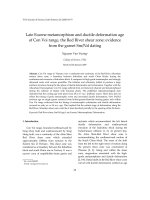
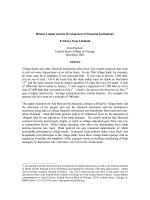
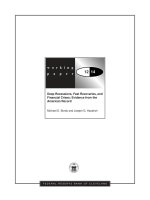
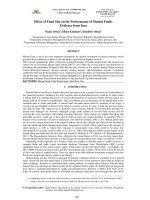



![khasharmeh and said - 2014 - effects of mandatory audit firm rotation upon quality of audit - the perception of audit firms-evidence from bahrain [marf]](https://media.store123doc.com/images/document/2015_01/06/medium_3d4BCTv20p.jpg)
